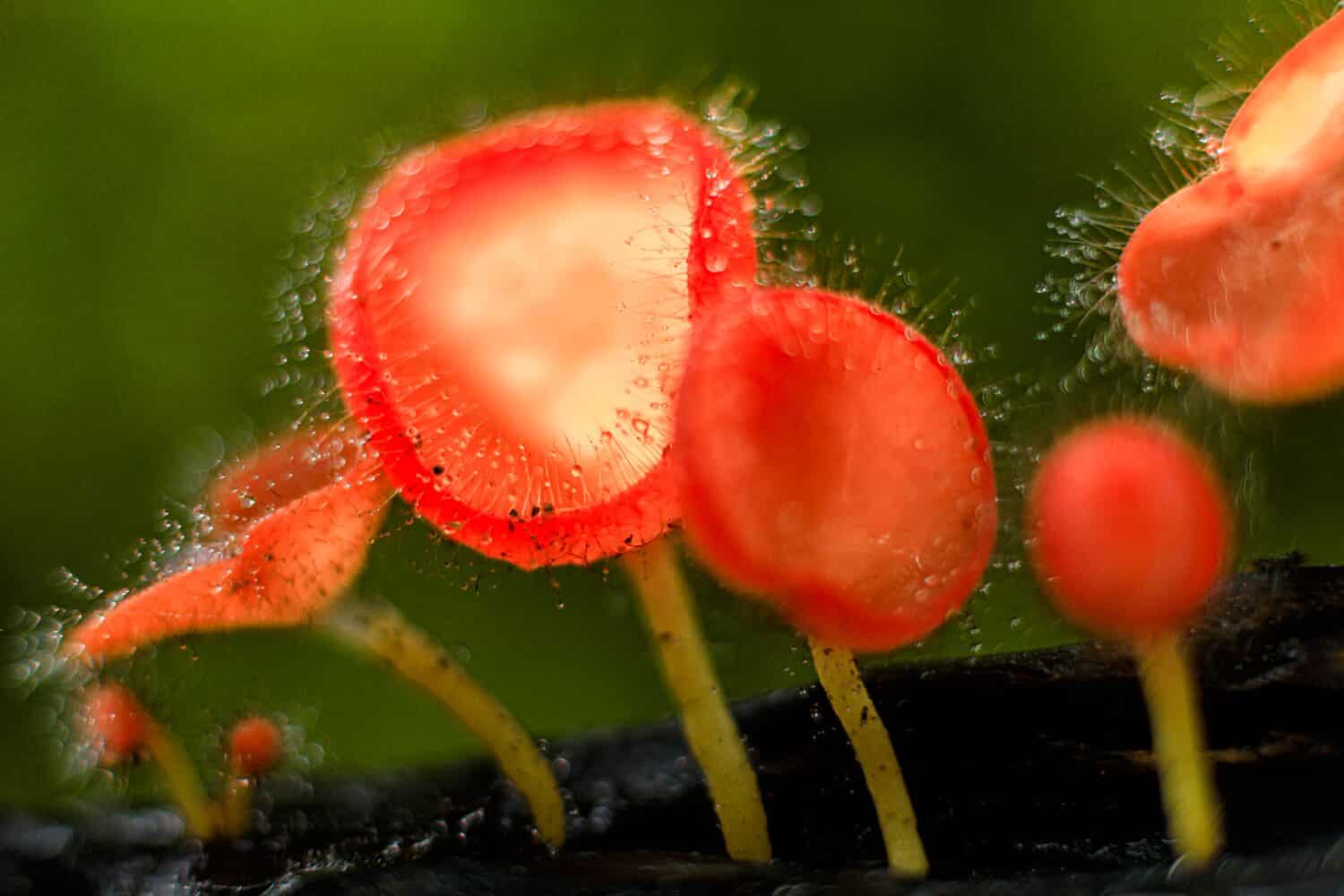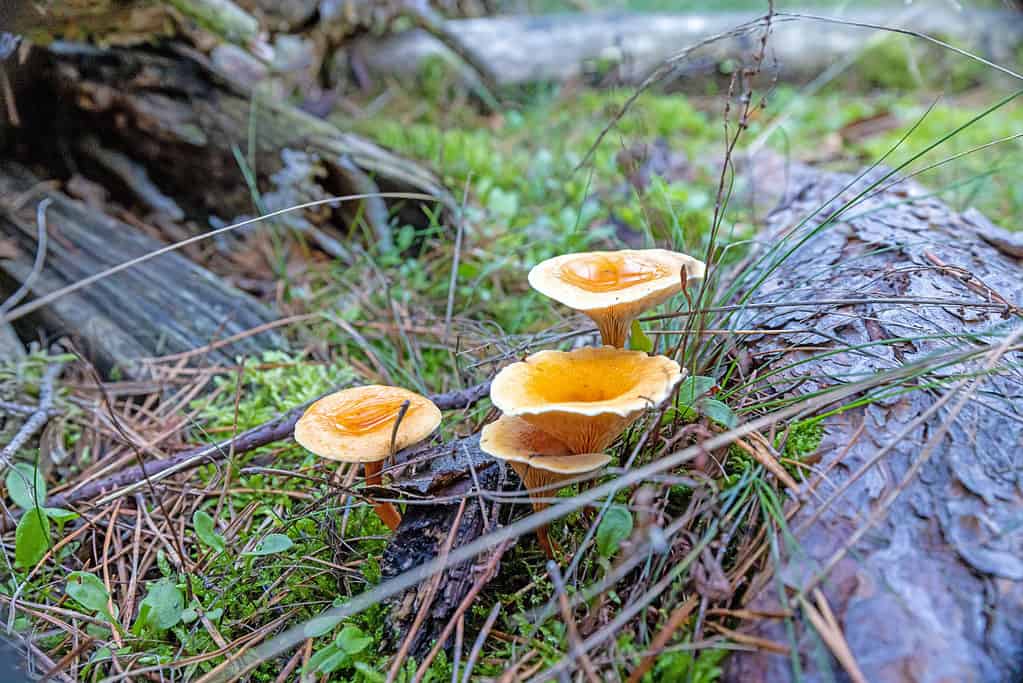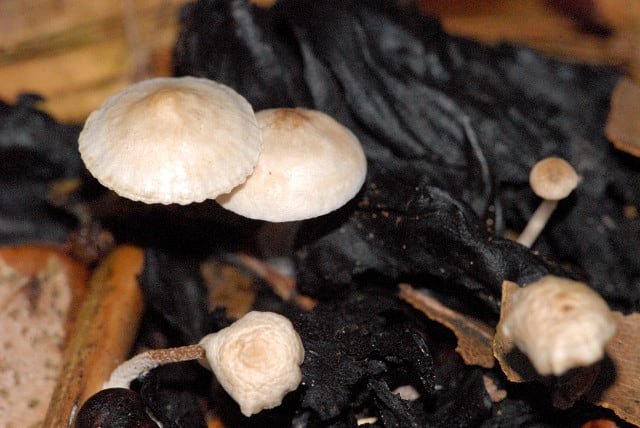Granted, even the largest non-puffball mushrooms aren’t all that large. But there are some mushrooms that are so tiny you really need a magnifying glass to get a good look at structures such as gills, veils, stems, and spores. With that in mind, here are five types of small mushrooms.
Types of Small Mushrooms: Marasmius

Marasmius mushrooms sometimes grow in rings called fairy circles.
©iStock.com/ariJ
This genus of mushrooms holds 500 species, many of which are small and easy to overlook. Some are edible, but some edible marasmius mushrooms are so small they’re not worth eating. Other species form fairy rings, especially after it rains. Their name comes from the Greek marasmius, which means “withering” or “drying out.” Elias Magnus Fries, a Swedish mycologist, noticed that these small mushrooms were marcescent, which means that they could be revived by water after they dried out. Characteristics of marasmius fungi are they have gills, convex caps, bare stems, and a white spore print. Species of these mushrooms include:
Orange Pinwheel Marasmius
This tiny mushroom, Marasmius siccus has a cap that’s only 0.12 to 0.94 of an inch wide, with a stalk that’s 0.39 to 2.75 inches long. It has a bell-shaped or convex cap that’s pleated and comes in shades of orange-brown, yellow-brown, or reddish-brown. It’s found all over North America, especially in the east, and springs up from the forest floor after a rain.
White Marasmius
M. candidus is the ghostly white mushroom seen growing in groups on decomposing twigs and branches from spring to the end of fall. The cap is about 0.39 to 1.38 inches wide. At first it’s flat but furls up with time. It has fine hairs and gills, with a stalk that’s 0.39 to 0.79 of an inch high.
Horse-hair Mushroom
This mushroom, M. crinisequi has a half-dome-shaped cap atop a very long, wiry stem that resembles a horsehair. This gives the mushroom its species name. Crinis is the Latin word for “hair” while equus means “horse.” The cap is only about 0.12 of an inch around, but the stem can be more than 3 inches high. The mushroom grows up from the forest duff and is found in Australia.
Mycena

Mycena mushrooms are tiny, and some glow in the dark.
©W. de Vries/Shutterstock.com
The caps of these small mushrooms are often fractions of an inch wide. They are called bonnets because of the caps are bell-shaped or conical. Their stems, or stipes are delicate. Mycenas are easy to overlook because of their small size, and many have gray or brown caps that just aren’t eye-catching. Some of them smell like radishes or chlorine, and others bleed latex if the stem is broken. Like a lot of marasmius mushrooms, a number are edible but are too small to bother with eating.
There are a good number of mycena mushrooms that glow in the dark. When this glow is seen in the woods it’s known as foxfire. Scientists don’t know why these fungi glow, but it may be a way to attract night-flying insects to help spread the spores. These spores, by the way, are only micrometers in diameter. Some Mycena mushrooms include:
Coral Spring Mycena
This mushroom, Mycena acicula has a cup that’s only 0.12 to 0.39 of an inch wide. At first, the cap is cone-shaped, then turns into a bell then flattens out and becomes convex. It differs from many other mycena mushrooms in that the cap is bright orange to red. The gills are attached to the underside of the cap and are yellow, orange, or off-white. The stalk is delicate and translucent and grows from 0.039 to 0.30 of an inch long.
Heavenly Light Mushroom
M. lux-coeli is one of the bioluminescent members of the genus. It’s found in Japan and glows green at night. The mushroom only lives for a few days and grows on the logs of chinquapin trees during the rainy season. The caps of these small fungi are only about an inch around.
Walnut Mycena
As its name suggests, this tiny mushroom only grows on nuts, usually buried hickory nuts or walnuts. The cap of M. crocea is between 0.2 to 0.4 of an inch wide. Cone-shaped at first, it gradually flattens out with age. Like the coral spring mycena, the cap starts out as brilliant orange then turns red, then yellow, then white. The edges of the cap also become translucent. The stalks are 2 to 4 inches long and are hollow and also translucent.
Cup Fungi

Some cup fungi are smaller than the letters on a penny. This is red hair cup fungi.
©Chicanio/Shutterstock.com
As the name states, these fungi have caps that are shaped like cups or bowls. They belong to several families divided into many genera and species, and though some cup fungi are fairly large, most of them are small. Some of these mushrooms help to break down organic material, some are pathogens on plants, and others form symbiotic relationships with trees.
Yellow Fairy Cup
This mushroom, Bisporella citrina, is also called the lemon disco. The smooth, lemon-yellow cups are 0.059 to 0.060 of an inch across, which means they can be smaller than a letter embossed on a penny. They’ll be about 0.039 of an inch high. Yellow fairy cups grow in clusters on logs and stumps stripped of bark during the summer and fall. It is a very common mushroom, distributed around much of the world, but so tiny it is easy to overlook. Its spores are micrometers wide, but if you use a magnifying glass, you’ll see that they’re oval-shaped, smooth, and with an infinitesimal drop of oil at both ends.
Deciduous Wood-Stalked Hairy Fairy Cup
Lachnum pudibundum has goblet or cup-like caps that are 0.059 to 0.16 of an inch wide and 0.079 to 0.24 of an inch tall. Inside, the cup is smooth and white, but the edges and outside of the cup are covered with white hairs. The stalk is also hairy. You’ll see this cup fungi in masses on decaying wood or on the bottom of logs from summer to fall. It may be edible, but like so many other little mushrooms, too small to bother with.
Shaggy Scarlet Cup
This tiny mushroom belongs to the Sarcoscyphaceae family. Its scientific name is Microstoma floccosum, which translates from the Latin into “fluffy little mouth.” The mushroom’s cup is 0.118 to 0.39 of an inch wide, scarlet and covered with white hairs. The inside of the cup is hairless and also scarlet. Use a magnifying glass to see the details of these hairs. The stalk is 0.79 to 1.38 inches long and also hairy, though white. The bright red color makes the mushroom easy to see on the decomposing oak twigs where it often grows.
Small Chanterelles

Chanterelles are choice mushrooms for the table. Even small chanterelles are sought after.
©iStock.com/Pictures-and-Pixels
Chanterelles are edible and prized for their taste, and Cantharellus minor is one of the smallest members of the genus. This mushroom has a cap that’s only 0.20 to 1.18 inches wide. When it first emerges, the cup is conical, then it becomes flat and depressed with wavy edges. Eventually, it can become funnel-shaped like other types of chanterelles. The color ranges from a deep yellowish orange to orange. The stalk is also orange, 0.59 to 1.57 inches long, and furrowed. Scientists believe small chanterelles form symbiotic, mycorrhizal relationships with moss and oak trees. The mushroom is native to the eastern part of North America but has also been found in India. Though small, this chanterelle is edible.
Silky Piggyback

This little mushroom is a parasite on other mushrooms!
©James Lindsey at Ecology of Commanster, CC BY-SA 2.5 – Original / License
This tiny mushroom, scientific name Asterophora parasitica, is a parasite on other mushrooms. Its cap is between 0.20 and 0.59 of an inch wide. At first, it’s shaped like a bell then turns flat. It’s white, with tints of a grayish lilac, smooth but covered with tiny fibrils. The stalk is between 0.40 and 1.18 inches long and becomes hollow as the mushroom ages. The silky piggyback prefers to grow on the caps of decaying mushrooms, mostly of the Russula or Lactarius genera.
Thank you for reading! Have some feedback for us? Contact the AZ Animals editorial team.








